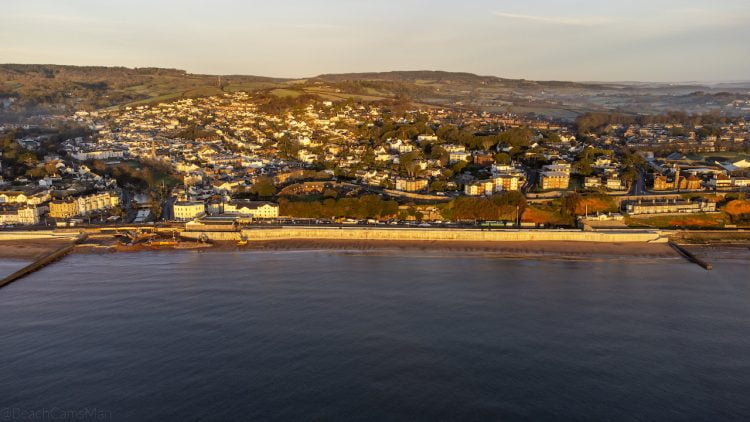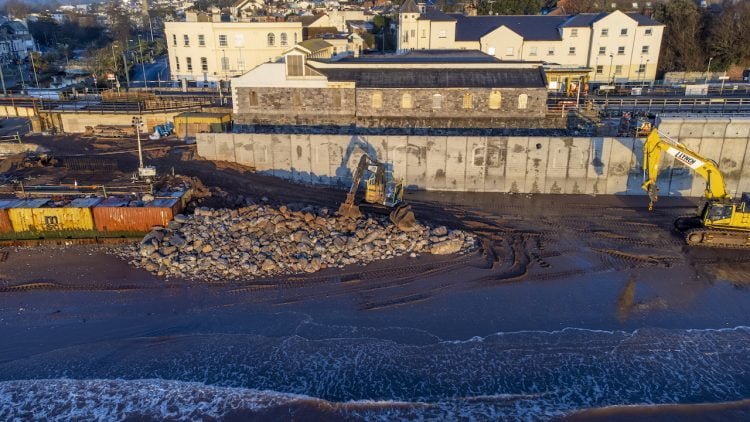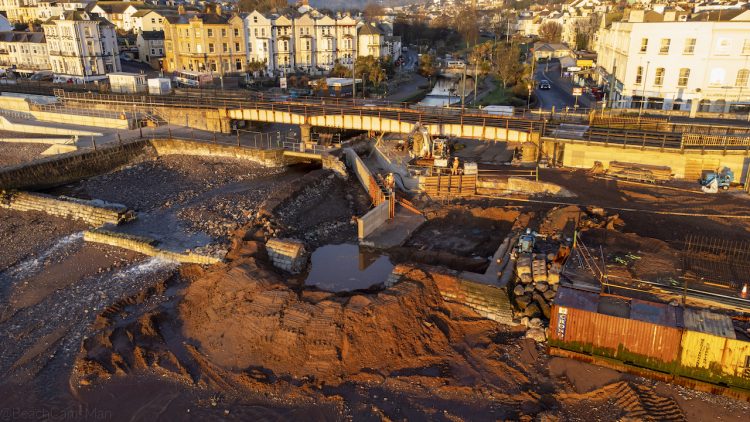Network Rail’s huge new sea wall project is making giant steps forward following the devastation caused by the infamous storm 8 years ago.
On the 4th of February 2014, a terrible storm raged causing severe damage to the railway on the South Devon Coastline, many people remember the awful scenes of Dawlish railway track swinging in the wind with a torrent of waves beneath. Eight years on and Network Rail‘s impressive new sea wall project is making great headway and bringing many benefits to the town and railway.
From the building of the first section of the new bigger sea wall back in May 2019, the coastline of Dawlish has seen an enormous transformation. Running for 360m along Marine Parade southwest of Dawlish station, the first section of new sea wall was finished in July 2020 with the construction of a 415m second section from Coastguard breakwater east of Dawlish station to Colonnade breakwater which got underway in November 2020.

The second section is making excellent progress with Network Rail’s contractors BAM Nuttall carrying out the successful installation of 143 concrete wall panels topped with curved wave returns creating a stretch of wall between the station building and Coastguard breakwater.
The inventive design of the wall panels with the curved wave returns alongside its increased height is already demonstrating a positive impact by keeping the tracks free of floods for trains running on this well-loved stretch of railway.
The promenade along the second section is also coming together with steps down to the beach at Coastguard breakwater now complete and the Coastguard’s footbridge set to reopen later this month.
The new sea wall is being made using the very latest in construction technology using low carbon concrete as part of the concrete backfill which creates a reduction in the project carbon impact by as much as two-thirds.
Whilst the project makes great strides forward, there is still much work to do and currently, engineers are focused on a temporary diversion for the Dawlish river water to allow work on the new stilling basin and further installation of the remaining piles between stilling basin and the station building.

Also underway, is a total rebuild of the seaward platform 1 which serves trains heading to Teignmouth and the resurfacing of the landward platform 2 which serves trains heading to Exeter. Teams of engineers are working right around the clock over four weekends through February in order to finish the work which will make it safer and easier for passengers to get on and off trains. Great Western Railway (GWR) are advising those travelling through this period of planned work to plan their journeys ahead, checking times before travelling.
It is expected that the promenade along the second section and also between the first and second sections of sea wall will be finished and open for the public to use in time for summer. Once opened, the new sea wall will mean that locals and visitors can walk between Dawlish and Dawlish Warren for its entire length.

The huge £80m project has been funded by the Department for Transport, will also see improvements made at Dawlish station such as an accessible station footbridge featuring lifts – will be completed during 2023 and will provide protection against rising sea levels and extreme weather conditions for both the town and the railway into the future.
Rail Minister, Wendy Morton, said: “The progress being made on Dawlish’s sea wall is incredible. We are investing £80 million to rebuild this iconic station, as well as making it more accessible for all passengers.”
“As extreme weather events become more common, we must do all we can to protect our transport network.”
“Investing in our railways is essential to levelling up the country and ensuring local economies can flourish.”
Julie Gregory, Network Rail senior sponsor, said: “It is brilliant to see the progress being made on the second section of sea wall in Dawlish and how it is really starting to take shape.”
“I’ve been mightily impressed with the transformation of this stretch of coastline which is testament to the hard work and dedication of our team of engineers and contractors BAM Nuttall.”
“This is a really significant project – not just for Network Rail but for Dawlish and the entire South West peninsula – because once complete this new, bigger sea wall will play a central role in protecting this town and this key railway route to the south-west from rising sea levels and extreme weather for generations to come and, we hope, prevent the events of 2014 ever happening again.”
Yan Sayles, BAM Nuttall Project Manager said: “Dawlish has been a job like no other. The location of the railway, sandwiched between the sea and the town, has made delivering the work incredibly challenging but enormously rewarding. It has pushed us to the limits of our knowledge and required us to develop new techniques and materials that have never been used in other rail projects before.”
“I’d like to thank the residents of Dawlish for their patience, hospitality and friendship over our years delivering this work. We know our work has sometimes caused noise and disturbance, but we hope that it will provide a lasting legacy which will benefit the town for many years to come. BAM and our suppliers are extremely proud of the work we’re delivering in Dawlish and I’d like to express my gratitude to everyone who has contributed to the effort so far.”
Councillor Jonathan Drean, Chair of Peninsula Rail Task Force, said: “The resilience and reliability of the mainline at Dawlish remains the top priority of the Peninsula Rail Task Force and therefore it is heartening to see the tremendous progress being made along the sea wall.”
“Completion of this programme of works is essential to increasing business confidence, attracting inward investment and supporting communities, tourism and economic growth right through the South West to South Devon, Plymouth and Cornwall.”
Councillor Val Mawhood, Mayor of Dawlish, added: “The great storm of 2014 is now a major part of Dawlish history and something that will be spoken about for generations to come.”
“This awful event showed just how vital this section of the rail network is for the whole of the South West and I welcome the progress which has been made on the new sea wall. This is already having a positive impact on the town and will ensure that history isn’t repeated.”
Mark Chorley, GWR Regional Station Manager, West, said: “This work is important to ensure we can continue to maintain and improve resilience and we thank customers for their patience in advance.”
“We have been working hard to provide as many replacement buses as we can to ensure people can continue to travel confidently and safely. However, we strongly recommend our customers check their times carefully before travelling to ensure a smooth journey with us.”
During February 2022, the Dawlish Information Hub which is located on Marine Parade will be open to the public on Saturdays from 12 to 2pm.
As part of Network Rail’s ongoing efforts since 2014, the new sea wall at Dawlish aims to improve the resilience of the railway between Dawlish and Teignmouth and is known as the South West Rail Resilience Programme or SWRRP.
For further information and to find out more about the latest developments, please visit: https://www.networkrail.co.uk/running-the-railway/our-routes/western/south-west-rail-resilience-programme/dawlish-sea-wall-section-two/






Responses
With a strong Easterly wind and a rough sea, trains along the sea wall will still be cancelled in the future.
8 years does seem a long time. And with the sea water that eroded the railway line that caused severe damage and severe delays and cancellations for months.